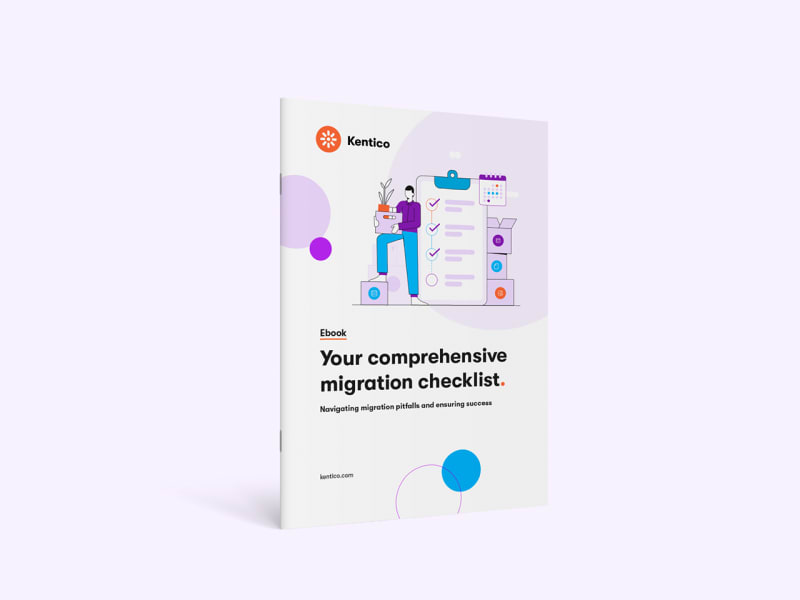In today's ever-evolving digital landscape, where a robust online presence is paramount for business success, digital experience platforms (DXPs) and Content Management Systems (CMS) play a pivotal role. From facilitating seamless content creation to ensuring a memorable user experience, these platforms form the backbone of a company's digital strategy.
However, businesses often hesitate to migrate systems due to concerns like cost implications, fear of disruption, lack of in-house expertise, legacy system dependencies, resistance to change, security risks, compliance complexities, and unrealistic timeframes. The perceived stability of their current solution and the perceived difficulty of transitioning away from it cast deeper shadows still over the decision-making process.
In the face of these concerns, it's worth contemplating whether the perceived pains of migration might pale in comparison to the potential long-term consequences and limitations imposed by sticking with an outdated system. Leaving an unfunctional or non-effective solution could be the key to unlocking enhanced efficiency, innovation, and sustained success in the dynamic digital landscape.
10 ways your outdated solution is letting you down
You might be inclined to think, “If it ain’t broke, don’t fix it." However, the decision to embark on migration is not merely a choice but a strategic imperative. Let’s look at all the ways an outdated solution can be quietly “broke” without you even realizing it.
- Lower return on investment (ROI): Outdated DXP and CMS platforms struggle to meet the demands of contemporary digital operations, leading to missed opportunities for cost savings, revenue, and improved user experiences crucial for optimizing ROI. These systems also incur elevated maintenance costs, requiring extensive support and customized patches, inflating expenses and undermining digital efficiency. Failing to consolidate a complex tech stack compounds these challenges, hindering operational efficiency, increasing implementation and maintenance costs, and obstructing potential revenue streams. In contrast, a DXP that centralizes management across multiple channels from a single platform streamlines operations, reduces complexities, and enhances efficiency, contributing to a more favorable ROI.
- Impeded agility: Outdated DXP platforms not only struggle with supporting new functionalities, causing inefficiencies and missed opportunities, but they also impede market agility, reducing your ability to swiftly adapt to evolving conditions. This can result in loss of market relevance and a diminished ability to stay ahead of the curve. Newer DXPs often introduce innovative features and technologies, allowing you to stay at the forefront of industry trends and adopt new capabilities.
- Inadequate customer experience: Outdated platforms can struggle to provide the seamless, personalized interactions consumers expect due to slower loading times and outdated marketing tools. What’s more, inconsistencies in presentation when delivering content across digital channels can erode your brand's identity and diminish its appeal. A modern DXP provides multichannel features and functionalities that can significantly improve the overall user experience, leading to increased customer satisfaction.
- Data security risks: Postponing DXP migration or upgrades can expose organizations to significant risks as outdated DXP platforms that are no longer supported by the vendor can lack essential security features, making them susceptible to cyber threats like malware and data breaches. Such vulnerabilities not only compromise sensitive information but also open the door to legal and financial consequences. Modern DXPs come equipped with advanced security features, helping safeguard your digital assets and sensitive information from cyber threats.
- Compliance concerns: Delaying migration or upgrades also poses a risk of non-compliance with regulations such as GDPR and CCPA. This can lead to severe penalties, legal actions, and investigations. Staying up to date with the latest DXP ensures that you meet regulatory compliance requirements.
- Decreased marketing efficiency and effectiveness: Lagging behind in content management capabilities may result in slower campaign launches, reduced personalization, and an inability to keep up with evolving digital marketing trends. This in turn affects overall business efficiency. Upgrading to a newer DXP often comes with a user-friendly user interface, improved workflow management tools, and centralized digital asset management, enhancing efficiency and productivity within your organization.
- Vendor misalignment: Outdated DXP platforms may no longer align with the evolving services or technologies offered by vendors, leading to a mismatch in expectations. They may necessitate custom solutions, additional support, or workarounds to integrate with evolving technologies. This dependency on outdated technology can lead to higher maintenance costs and missed opportunities for innovation. Migrating or upgrading to an updated DXP can improve collaboration with vendors, ensuring alignment with evolving services and technologies, reducing maintenance costs, and avoiding potential vendor lock-in.
- Globalization challenges: Outdated systems may struggle to handle diverse regional requirements. Failure to tailor content to diverse audiences can result in decreased engagement, loss of market share, and damage to brand perception in specific regions. Advanced DXPs can better handle diverse regional requirements, enabling effective content adaptation to various cultural norms, legal regulations, and user preferences, enhancing your global reach.
- Reduced scalability: As business demands grow, outdated systems struggle to accommodate increased content, user traffic, and evolving functionalities. This can result in a sluggish digital presence, downtime, and a loss of opportunities for expansion. Modern DXPs are designed to handle increased content, user traffic, and evolving functionalities, providing scalability to support your business growth.
- Lack of futureproofing: Delaying migration or upgrades can lead to increased technical debt, requiring more substantial investments in the future to rectify issues, implement new features, or adapt to emerging technologies. Newer DXPs often introduce innovative features and technologies, allowing you to stay at the forefront of industry trends and adopt new capabilities.
The "if it ain't broke, don't fix it" mindset ignores the strategic importance of upgrades and migration, risking diminished ROI, hindered market agility, compromised customer experience, and more. To minimize issues, opt for a seamless transition to a contemporary DXP, addressing immediate challenges while positioning your digital strategy for sustained success and innovation.
The numbing agent: migration toolkits
The best-case scenario when migrating from platform A to platform B, would of course be that vendor B provides a special A to B migration toolkit. But how often does that happen?
The next best scenario would be when the vendor you’re moving to provides a toolkit that will support migration from various platforms to theirs—a universal migration toolkit (UMT). Not a lot of DXP vendors provide such a tool, which is surprising as it can significantly simplify and streamline the migration process.
A universal migration toolkit is a comprehensive set of pre-built tools, scripts, and resources designed to facilitate the seamless transfer of data, content, and configurations from an existing system to a new platform. This toolkit plays a crucial role in simplifying and expediting the migration or upgrading process for businesses looking to transition from outdated or incompatible systems to a more advanced and feature-rich solution.
Key features of a universal migration toolkit include:
- Standardized process: A universal migration toolkit provides a standardized process for migrating data and configurations, reducing the complexity of the migration workflow. Standardization ensures consistency across different migrations, making it easier to manage and troubleshoot potential issues.
- Efficiency and automation: Toolkits offer automation features that help automate repetitive tasks involved in the migration process. Automation improves efficiency, reduces manual errors, and accelerates the overall migration timeline.
- Reduced dependency on custom development: The toolkit may offer pre-built connectors and adapters for common systems and databases, reducing the need for custom development efforts. This minimizes the risk of compatibility issues and accelerates the integration process.
- Comprehensive data mapping: Universal migration toolkits typically include features for comprehensive data mapping, ensuring that data from the source system is accurately mapped to the target system. Detailed data mapping reduces the risk of data loss or corruption during the migration.
- Adaptability to different systems: The toolkit is designed to be adaptable to various systems and scenarios, allowing businesses to migrate from different platforms and technologies. This flexibility is particularly beneficial for businesses with diverse IT ecosystems.
- Vendor support and updates: Vendors often provide support and updates for their migration toolkit, addressing compatibility issues, introducing new features, and ensuring ongoing reliability. This ongoing support contributes to the long-term success and sustainability of the migration process.
- Cost-efficiency: Utilizing a universal migration toolkit can be cost-effective compared to developing custom migration solutions or, worse still, performing resource-intensive manual migrations. The toolkit enhances efficiency and accuracy by automating the migration process and eliminates the need for extensive custom coding, reducing both development time and associated costs.
- Minimized downtime: With automation and standardized processes, the migration can be executed more efficiently, minimizing downtime for critical business operations. Reduced downtime is particularly crucial for businesses where continuous operation is essential.
At Kentico, we believe that the incorporation of a UMT in your migration strategy can be a game-changer, and that’s why we’ve built our own. To make your move to our next-generation hybrid-headless DXP, Xperience by Kentico, as smooth as it can be. Our open-source UMT is rigorously tested and supported by Kentico, ensuring our ability to assist you effectively in its utilization. And, of course, it consistently aligns with the latest version of the product.
In fact, we’re even working on a best-case-scenario migration toolkit from Sitecore to Kentico. So, watch this space!
If you’d like to learn more about migrating to Kentico, then why not check out some of these resources:
- Explore the free Xperience by Kentico Migration Toolkit
- Try the Kentico Migration Tool to help you bring your content and data from older versions of Kentico to Xperience by Kentico
- Try the Sitecore Migration Tool to migrate content in a Sitecore solution to Xperience by Kentico
- Try the Sitefinity Migration Tool to transfer your Sitefinity content to Xperience by Kentico
- Or, try the Universal Migration Tool to migrate data from any data source (ERP, PIM, or legacy CMS) to Xperience by Kentico
- Kentico’s migration and upgrade assessment
- Upgrading from Kentico Xperience 13 to Xperience by Kentico
Get more advice with our free ebook, Your comprehensive migration checklist.


